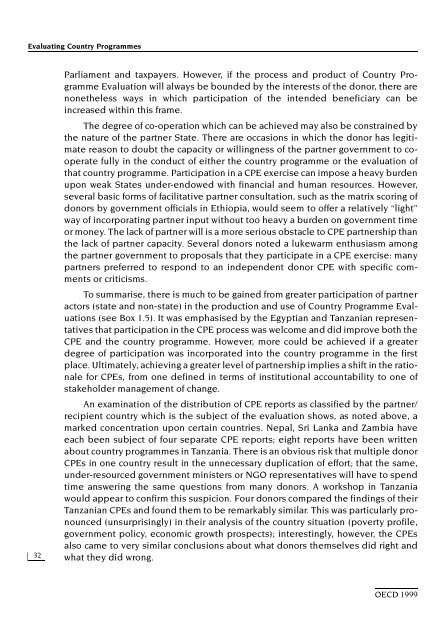Evaluating Country Programmes - OECD Online Bookshop
Evaluating Country Programmes - OECD Online Bookshop
Evaluating Country Programmes - OECD Online Bookshop
You also want an ePaper? Increase the reach of your titles
YUMPU automatically turns print PDFs into web optimized ePapers that Google loves.
<strong>Evaluating</strong> <strong>Country</strong> <strong>Programmes</strong><br />
32<br />
Parliament and taxpayers. However, if the process and product of <strong>Country</strong> Programme<br />
Evaluation will always be bounded by the interests of the donor, there are<br />
nonetheless ways in which participation of the intended beneficiary can be<br />
increased within this frame.<br />
The degree of co-operation which can be achieved may also be constrained by<br />
the nature of the partner State. There are occasions in which the donor has legitimate<br />
reason to doubt the capacity or willingness of the partner government to cooperate<br />
fully in the conduct of either the country programme or the evaluation of<br />
that country programme. Participation in a CPE exercise can impose a heavy burden<br />
upon weak States under-endowed with financial and human resources. However,<br />
several basic forms of facilitative partner consultation, such as the matrix scoring of<br />
donors by government officials in Ethiopia, would seem to offer a relatively “light”<br />
way of incorporating partner input without too heavy a burden on government time<br />
or money. The lack of partner will is a more serious obstacle to CPE partnership than<br />
the lack of partner capacity. Several donors noted a lukewarm enthusiasm among<br />
the partner government to proposals that they participate in a CPE exercise: many<br />
partners preferred to respond to an independent donor CPE with specific comments<br />
or criticisms.<br />
To summarise, there is much to be gained from greater participation of partner<br />
actors (state and non-state) in the production and use of <strong>Country</strong> Programme Evaluations<br />
(see Box 1.5). It was emphasised by the Egyptian and Tanzanian representatives<br />
that participation in the CPE process was welcome and did improve both the<br />
CPE and the country programme. However, more could be achieved if a greater<br />
degree of participation was incorporated into the country programme in the first<br />
place. Ultimately, achieving a greater level of partnership implies a shift in the rationale<br />
for CPEs, from one defined in terms of institutional accountability to one of<br />
stakeholder management of change.<br />
An examination of the distribution of CPE reports as classified by the partner/<br />
recipient country which is the subject of the evaluation shows, as noted above, a<br />
marked concentration upon certain countries. Nepal, Sri Lanka and Zambia have<br />
each been subject of four separate CPE reports; eight reports have been written<br />
about country programmes in Tanzania. There is an obvious risk that multiple donor<br />
CPEs in one country result in the unnecessary duplication of effort; that the same,<br />
under-resourced government ministers or NGO representatives will have to spend<br />
time answering the same questions from many donors. A workshop in Tanzania<br />
would appear to confirm this suspicion. Four donors compared the findings of their<br />
Tanzanian CPEs and found them to be remarkably similar. This was particularly pronounced<br />
(unsurprisingly) in their analysis of the country situation (poverty profile,<br />
government policy, economic growth prospects); interestingly, however, the CPEs<br />
also came to very similar conclusions about what donors themselves did right and<br />
what they did wrong.<br />
<strong>OECD</strong> 1999

















![CQE=U]^\]Z: KAZAKHSTAN - OECD Online Bookshop](https://img.yumpu.com/3915768/1/190x253/cqeuz-kazakhstan-oecd-online-bookshop.jpg?quality=85)